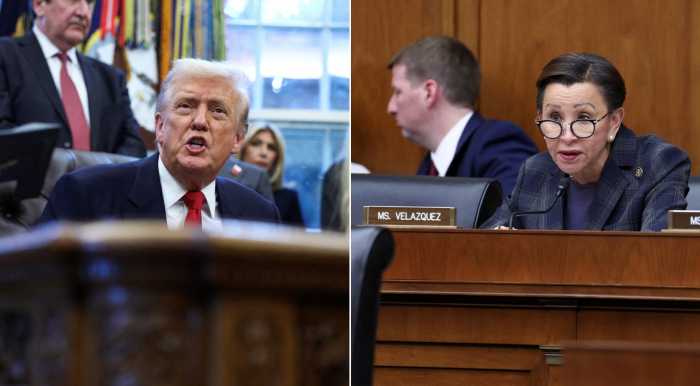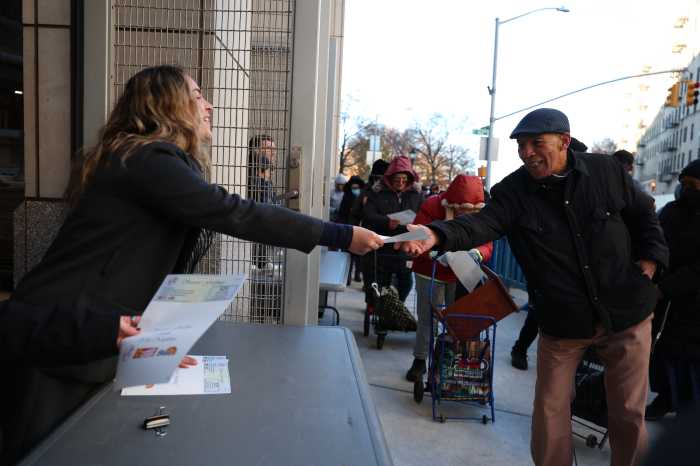Christian Patrick and Val Lauren in James Franco and Travis Mathews’ “Interior. Leather Bar.” | STRAND RELEASING
Filmmaker Travis Mathews garnered considerable attention for his debut feature, “I Want Your Love,” and not just because it featured explicit gay sex. It was a poignant, intimate drama about a gay man facing a crossroads in his life. The film caught the attention of actor, writer, and director James Franco, who contacted Mathews about a project he wanted to do that plays off “Cruising,” the controversial 1980 William Friedkin thriller starring Al Pacino set in New York City’s gay S & M scene.
Their collaboration, “Interior. Leather Bar.” re-imagines 40 lost minutes from Friedkin’s film. Actor Val Lauren, a straight friend of Franco’s, plays the Pacino role and his anxiety about being on set and shooting a gay film forms the arc for the hybrid documentary-drama.
“James wanted to compare and contrast where we were with graphic sex in 1980 and where we are now with sexuality on screen,” the soft-spoken filmmaker recounted in a Skype interview. “I wanted the texture of the film and the way it was constructed to reflect Val’s experience, and [his] second guessing [his] boundaries — a constant feeling of unease. I wanted to play with boundaries that played with what queer means.”
Travis Mathews, James Franco interrogate heterosexual unease at entering the foreign turf of gay sexuality
Before Mathews agreed to make “Interior. Leather Bar.,” he spoke at length with Franco to confirm they shared the same politics and temperaments. “That we were approaching something controversial from a similar point of view,” he said.
When they decided to co-direct the film, Mathews recalled, the question arose, “How are you actually going to do this!?” He explained that Franco’s approach was very much “We’ll figure it out and go with the flow.” Mathews was far more structured, with shot lists and scene numbers despite having a skeletal treatment of the project.
The approaches complement each other. Franco is mostly seen counseling his friend Lauren, often telling him to just go for it, despite the actor’s obvious reservations. Mathews focuses more on directing and establishing the supporting characters’ roles and actions, such as their body language in the leather club and in an explicit sex scene.
One thing determined early on was that the filming would take place in Los Angeles. While “Cruising” was set in New York and the co-directors could not recreate 1980s Manhattan, they made the decision, Mathews said, “to expose the apparatus and drive home the fact that we are in LA and this is the making of a movie.” Scenes set outside in the parking lot feature a helicopter overhead, and other telltale LA signs.
Mathews said he first saw “Cruising” as a 20-year-old on VHS and had viewed it at least three times before Franco contacted him about making “Interior. Leather Bar.” His reaction to the film was mixed, not unlike the ambiguous feelings many gay men had about it when it was made.
“It felt problematic to me,” he explained. “I understood why it was protested and why it was a lightning rod. But it remained an intriguing film to me as a young gay man because it exposed me to a subculture I didn’t know.”
In working on the project with Franco, Mathews dug down deeper in his thinking about the film.
“One of the things that I have unpacked since doing this project and having to re-watch it was the bar scenes — they were real venues, with real patrons,” he said. “It was docu-fiction. Friedkin instructed the [gay men] to do what they did — drink, smoke, do drugs, fuck. If you look at the bar scenes in ‘Cruising,’ they were important representations of the bar scene in New York City pre-AIDS. The fact that the film is so homophobic eclipses the fact that the B-roll bar scenes and montages create a really interesting and really important document of that time.”
While “Interior. Leather Bar.” re-creates that bar scene feeling, with naked actors being spanked with a paddle by a hot guy in chaps, the focus of the film is the journey Lauren’s character must travel in making the film-within-a-film.
Mathews explained, “When you strip down ‘Cruising’ to its bare elements, it’s a straight man going into a gay culture and it changes him. We created a parallel arc in our film, by having our actor going on to a set.”
From this perspective, “Interior. Leather Bar.” is less about what might have been in those missing 40 minutes of “Cruising” and more a docu-fiction about creating that sequence. Mathews’ aim was to forge a space that shifts between reality and fiction. One terrific moment has two actors conversing candidly and then one is suddenly fed a line.
But the sex is a storytelling tool, too, as Mathews and Franco discuss in the film’s opening scene. Late in the film, Lauren observes an erotic coupling between real life partners that has an effect on him.
One of Mathews’ goals in the film is for the audience to identify with Lauren’s character, who is confronting something that makes him feel uncomfortable. While gay men might find his character a bit irritating, according to Mathews, straight men who have seen the film find themselves checking their own homophobia in ways that Lauren does.
“Interior. Leather Bar.” cannot be considered a mainstream film. Mathews made clear his intent was “to make a queer film that was challenging and provocative in the ways it was constructed — what we bring up and what we show. To me, that’s queer, and I don’t use that word lightly. It became clear to me that that was the project we were spearheading. And I embraced that.”
INTERIOR. LEATHER BAR. | Directed by James Franco and Travis Mathews | Strand Releasing | Opens Mar. 5 | IFC Center, 323 Sixth Ave. at W. Third St. | ifccenter.com


















